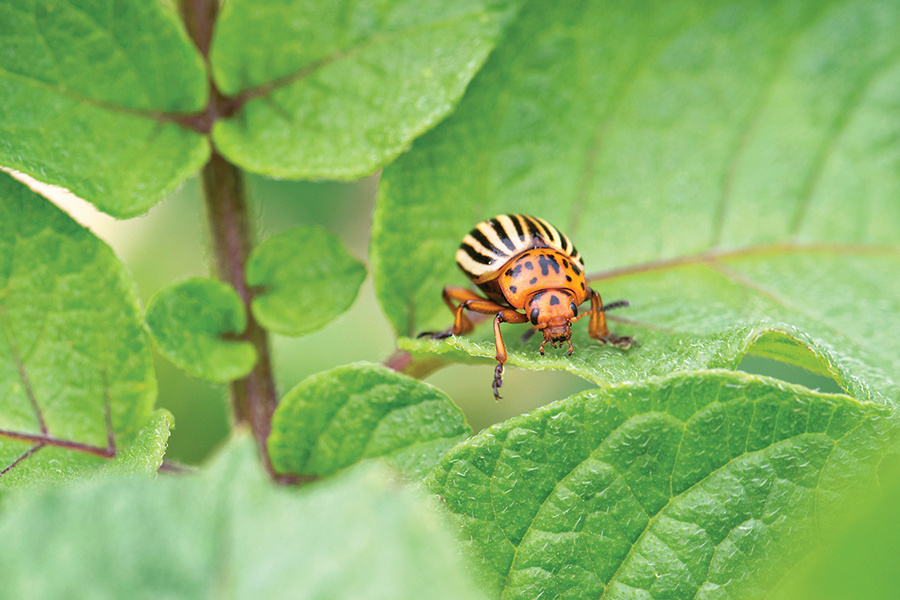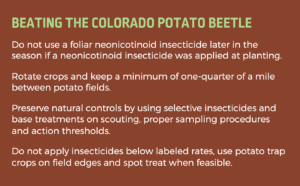
Neonicotinoids face growing resistance
Neonicotinoid insecticides are important for managing Colorado potato beetles and aphids in potatoes, but challenges to their use are growing.
More retailers are requiring their suppliers to use integrated pest management practices, and other retailers are phasing out products that contain the insecticide altogether.
EPA’s review of the impact of neonicotinoids (commonly called neonics) on endangered species continues, with indications that their use will be restricted in the future. Critics have linked widespread neonic usage with rising resistance among pest populations, harm to pollinators and environmental contamination. As a result, major retailers such as Walmart and Costco have encouraged fresh produce suppliers to phase out the chemicals.
 Resistance issues have slowly reduced the effectiveness of neonics for controlling Colorado potato beetles, shortening their efficacy window. Vegetable entomology research from the Groves Lab at the University of Wisconsin found the efficacy window has been shortened by 50 days since the insecticides were registered in 1995. This translates to 3.3 more calendar days of lost control or 35 Growing Degree Days (GDD) per year.
Resistance issues have slowly reduced the effectiveness of neonics for controlling Colorado potato beetles, shortening their efficacy window. Vegetable entomology research from the Groves Lab at the University of Wisconsin found the efficacy window has been shortened by 50 days since the insecticides were registered in 1995. This translates to 3.3 more calendar days of lost control or 35 Growing Degree Days (GDD) per year.
GDD is a weather-based crop development calculation that measures heat accumulation to predict plant and pest development rates.
“At one time, an at-planting application offered much more effective control,” said Zsofia Szendrei, professor and vegetable Extension specialist in the Department of Entomology at Michigan State University. “Now, growers are only getting a month to a month and a half of control, or maybe a little longer.”
Szendrei, who researches chemical ecology, biological control, habitat management and behavioral pest management, is leading a national potato research team looking for neonicotinoid alternatives.
USDA’s Specialty Crop Research Initiative announced funding for a $6 million project to study insect pest management strategies for potatoes in February. A key goal of the project, supported by Potatoes USA, is to explore alternatives to using neonicotinoids.
Colorado potato beetles are good at adapting to toxins in insecticides because they evolved to feed on the leaves of solanaceous plants which contain toxic alkaloids. Solanaceous plants are of the nightshade family and include potatoes, tomatoes, eggplants and peppers.
Exposure to sublethal doses of neonicotinoids is another reason for increasing resistance, as is the over-reliance on a single class of insecticide.
Neonicotinoids have many commercial names and several active ingredients, including imidacloprid, thiamethoxam, acetamiprid, clothianidin and dinotefuran. All of the active ingredients are in the same MoA (Mode of Action) class of 4A, and they kill insects in the same way.
The overall result of the increased resistance is that more scouting and more foliar applications are needed to control Colorado potato beetle.
In the meantime, following the standard strategy for managing Colorado potato beetle resistance continues to be the best plan, experts say:
- Do not use a foliar neonicotinoid insecticide later in the season if a neonicotinoid insecticide was applied at planting.
- Rotate crops and keep a minimum of one-quarter of a mile between potato fields.
- Preserve natural controls by using selective insecticides and base treatments on scouting, proper sampling procedures and action thresholds.
- Do not apply insecticides below labeled rates, use potato trap crops on field edges and spot treat when feasible.














